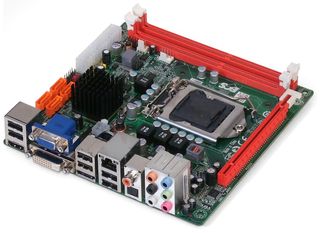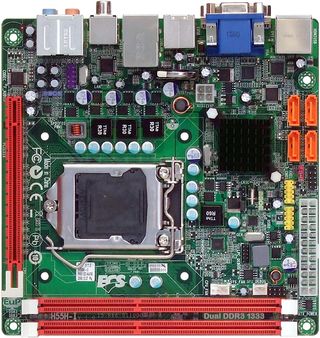Budget Computing: Nine H55 And H57 Motherboards Compared
ECS H55H-I Mini-ITX
When asked to provide its best features-for-the-money motherboard, ECS surprised us by sending a mini-ITX unit. Short on size, but par for the course with regard to features, the H55H-I supports up to two monitors from its HDMI, DVI, and VGA connectors. It also offers eSATA, and both coaxial and optical digital audio outputs.

Anyone who’s ever wondered why so many mini-ITX cases have dual slots when the motherboards support only a single card need look only at the H55H-I’s PCIe x16 2.0 slot, an interface that can support even the fastest graphics cards. Finding a high-capacity power supply to fit those small cases becomes the biggest challenge in building an ultra-portable gaming PC.

Yet, we know that AMD’s DTX standard is the real reason why cases such as Silverstone’s Sugo SG05 have two slots, and crowding around the CPU socket makes us wish the larger “tiny” standard had prevailed. Arctic Cooling’s Freezer 7 Pro Rev.2 performance CPU cooler still fits the H55H-I in standard orientation with memory modules up to 35mm tall.
It’s difficult to criticize the H55H-I layout without suggesting alternatives that simply don’t exist. The mini-ITX form factor leaves no room at the front edge, so builders who need something a little smaller than microATX are often forced to live VIA’s dream, regardless of its limitations.
BIOS Features
Overclocking settings might be the most surprising feature of ECS’ H55H-I, with voltage and frequency limits that probably exceed the capabilities of any component that fits into such a small area.


Setting the performance level to Enhanced reveals the CPU ratio setting, but prevents the system from booting. Putting aside that little BIOS glitch, we were able to use the full range of DRAM timings, adjust CPU base clock, and set reliable voltage levels for our dual-core processor.
Stay on the Cutting Edge
Join the experts who read Tom's Hardware for the inside track on enthusiast PC tech news — and have for over 25 years. We'll send breaking news and in-depth reviews of CPUs, GPUs, AI, maker hardware and more straight to your inbox.
Accessories

The capacity limits of typical mini-ITX cases removes any reservations we might have otherwise had about the presence of only two SATA cables in its installation kit.
-
Crashman wintermintDo anyone know how good is the integrated graphics found in these mobos? Can it handle some games?Reply
It's not on the motherboard, it's on the CPU. Different CPU's have different clock speeds for the GPU. And it can't even play most games, let alone play them smoothly:
http://www.tomshardware.com/reviews/intel-clarkdale-core-i5-661,2514-11.html -
liquidsnake718 useless... this is just for HD movies and simple web based games, onboard gpus on motherboards are even better than this intel..... i wonder if this was larrabee...... or if larabee will really come to fruitition as I read in a toms article its basically dead.... however i wonder if this was larrabee.....Reply -
anamaniac I'm sad to see Quantum Force (Foxconn's enthusiast line, such as the Bloodrage) die.Reply
At least Foxconn still makes really cheap stuff...
Honestly though, I'm more interested what's the lowest voltage you can get on stock clocks and DDR3 1066 cas6.
=) -
dertechie wintermintDo anyone know how good is the integrated graphics found in these mobos? Can it handle some games?Reply
The IGP is integrated into the Clarkdale CPU. I believe it is simply a further evolution of the X4500HD, and can at least now claim to be on rough par with ATI's integrated graphics, assuming that AMD hasn't done much to up the ante in the 800-series chipsets. Check the reviews of the i5-661 and the i3-5x0s. The 661 is the fastest IGP they sell (there's a reason reviewers all got that particular chip), at 900 MHz, the others are clocked at 733 MHz or 533 MHz. No, it can't run Crysis.
Larrabee is dead, it wasn't worth it to Intel to actually build it. The project isn't dead, but Larrabee Mk I will never see mass production silicon. -
enzo matrix Why do you guys only ever compare P55 and P57 boards? What about AM3? Or even 775 and AM2+?Reply -
anamaniac wintermintDo anyone know how good is the integrated graphics found in these mobos? Can it handle some games?Reply
http://techgage.com/article/overclocking_intels_core_i5-661/1
Intel i5-661.
CPU at 4.3GHz. IGP at 1133MHz. Both are at stock clocks.
ASUS P7H55D-M EVO
Crysis Warhead (1024x768, assuming low settings), 26FPS.
It can play Crysis. =) -
ta152h enzo matrixWhy do you guys only ever compare P55 and P57 boards? What about AM3? Or even 775 and AM2+?Reply
At least they moved to H55/H57, which is a platform that should sell a lot, rather than the brain-damaged P55 platform, which most sites spend a lot of time trying to convince (not that successfully, based on the bad sales) is a great platform.
Lynnfield/P55 is such a strange product, and appeals to such a limited segment of the market. It's not cheap, but it's a high-end product either. So, you get squeezed by x58, which is the real platform, or LGA 775, and now H55/H57 from below. It's not a big market segment, and I think it makes Intel's line a little confusing to average consumers, especially since the Clarksdale CPUs overlap it in cost from below, and the Bloomfield do from above.
It's obvious Intel didn't want to release CPUs with an IMC for the mainstream until they could move the IGP on-board the CPU. Since the IGP has to use the memory controller, there are compromises however you do it when you have an IMC. You either go to the processor, or you add the logic on the IGP (making it redundant), so Intel avoided that problem by putting it on the processor. The P55 is again neither fish nor fowl. It's got limited PCIe lanes, but doesn't have an IGP either.
There's a small segment where it makes sense. It's power efficient and the performance is only slightly less than Bloomfield in many situations, but I think the average consumer is going to find the H55/H57 much better for their needs (an IGP is critical in this market), and the enthusiast will want the full-blown Bloomfield. For that reason I think these motherboards are significant even though the P55 isn't. Maybe you don't want it, but, you'll probably have a friends/family neighbors asking about a computer with these products. They aren't technical marvels with their weird memory controller placed in the video controller, but aside from the distasteful technical compromises Intel made, they still address the market and needs of most people very well. The only one that is so offensive I could never bring myself to recommending is the new Pentium version. It probably is fine for most people, but it's so offensive, it's painful to recommend. I think LGA 775 is better at that point. Or AMD, of course. -
daniel266 WOW ! one more article about intel !! why im not suprised... hope that this comment dont disapear magically...Reply -
JohnnyLucky Thank you for including audio & video encoding benchmarks and productivity benchmarks.Reply
Most Popular


